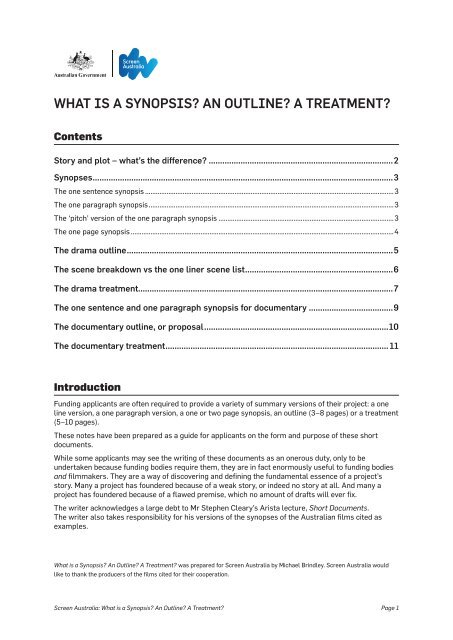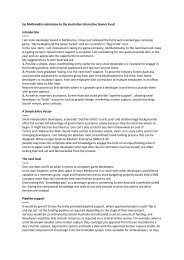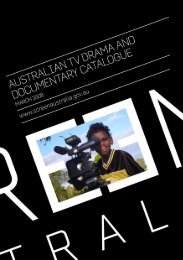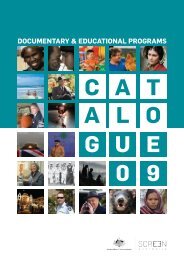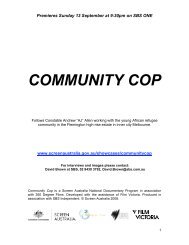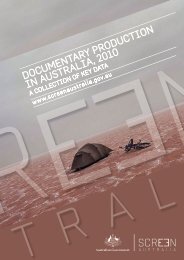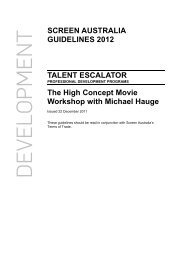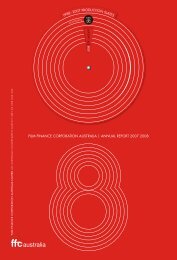What IS a SYNOPSIS? aN OUtLINE? a tREatMENt - Screen Australia
What IS a SYNOPSIS? aN OUtLINE? a tREatMENt - Screen Australia
What IS a SYNOPSIS? aN OUtLINE? a tREatMENt - Screen Australia
You also want an ePaper? Increase the reach of your titles
YUMPU automatically turns print PDFs into web optimized ePapers that Google loves.
WHAT <strong>IS</strong> A SYNOPS<strong>IS</strong>? AN OUTLINE? A TREATMENT?<br />
Contents<br />
Story and plot – what’s the difference? .................................................................................2<br />
Synopses ....................................................................................................................................3<br />
The one sentence synopsis ...........................................................................................................................................3<br />
The one paragraph synopsis .........................................................................................................................................3<br />
The ‘pitch’ version of the one paragraph synopsis ..................................................................................................3<br />
The one page synopsis ...................................................................................................................................................4<br />
The drama outline .....................................................................................................................5<br />
The scene breakdown vs the one liner scene list .................................................................6<br />
The drama treatment................................................................................................................7<br />
The one sentence and one paragraph synopsis for documentary .....................................9<br />
The documentary outline, or proposal .................................................................................10<br />
The documentary treatment .................................................................................................. 11<br />
Introduction<br />
Funding applicants are often required to provide a variety of summary versions of their project: a one<br />
line version, a one paragraph version, a one or two page synopsis, an outline (3–8 pages) or a treatment<br />
(5–10 pages).<br />
These notes have been prepared as a guide for applicants on the form and purpose of these short<br />
documents.<br />
While some applicants may see the writing of these documents as an onerous duty, only to be<br />
undertaken because funding bodies require them, they are in fact enormously useful to funding bodies<br />
and filmmakers. They are a way of discovering and defining the fundamental essence of a project’s<br />
story. Many a project has foundered because of a weak story, or indeed no story at all. And many a<br />
project has foundered because of a flawed premise, which no amount of drafts will ever fix.<br />
The writer acknowledges a large debt to Mr Stephen Cleary’s Arista lecture, Short Documents.<br />
The writer also takes responsibility for his versions of the synopses of the <strong>Australia</strong>n films cited as<br />
examples.<br />
<strong>What</strong> is a Synopsis? An Outline? A Treatment? was prepared for <strong>Screen</strong> <strong>Australia</strong> by Michael Brindley. <strong>Screen</strong> <strong>Australia</strong> would<br />
like to thank the producers of the films cited for their cooperation.<br />
<strong>Screen</strong> <strong>Australia</strong>: <strong>What</strong> is a Synopsis? An Outline? A Treatment? Page 1
Story and plot – what’s the difference?<br />
In the finished film, story and plot become one, but in conception they are not necessarily the same<br />
thing. Plot is the means to tell the story, and may be sweeping or intricate, epic or intimate. It may<br />
be linear or play with time. It may be couched in this genre or that. The dramatic and thematic – or<br />
perhaps market – needs of the story will dictate the plot, but there has to be a strong story in the first<br />
place.<br />
Story, as distinct from plot, is the key emotional relationships and conflicts of characters in pursuit of<br />
their goals, which develop into a series of events.<br />
For instance, the story of Othello has been told as a Western (Jubal), the story of High Noon has been<br />
told as sci-fi (Outlands) and Emma has been told as a teen-pic (Clueless). In each case setting, mode of<br />
storytelling and even plot depart from the original version of the story, but the key emotional conflicts,<br />
moral dilemmas and themes remain the same. However, when asked “<strong>What</strong> is your story about?”, many<br />
filmmakers launch into the plot – ie explaining what happens. For instance, here is a version of the plot<br />
premise of Proof:<br />
Martin, a blind photographer, spurns his sexy housekeeper, Celia, who loves him. When Martin<br />
chooses kitchen hand Andy to describe his photographs – the “proof” of Martin’s existence – a<br />
triangular struggle begins…<br />
The plot premise is an ideal hook. It can be suggestive, intriguing, exciting and create that very<br />
necessary curiosity about ‘what happens next’.<br />
But Proof also has a thematic premise – that is, what it is ’about’: trust. We can do no better than to<br />
quote the poster for the movie:<br />
Before love comes trust, and before trust, comes proof.<br />
This formulation may be more abstract, less intriguing and less of a hook, but it gives us the proposition<br />
that the story dramatises; it dictates what happens, what is included (and excluded) and it keeps the<br />
story and the plot on track.<br />
It is essential to have some notion of what theme or proposition the story dramatises, or the argument<br />
the whole story demonstrates and therefore ’proves’. It is the filmmakers’ reason for telling the story<br />
and it is a way of convincing others that the story is worth telling.<br />
Conversely, a strong, noble or worthy premise alone will not save or justify a weak story.<br />
Whether or not filmmakers disclose their thematic premise, it is always useful to know what it is –<br />
that is, what their story is ‘about’ – when writing a one paragraph summary, an outline, a synopsis, a<br />
treatment, or even the script.<br />
Page 2 <strong>Screen</strong> <strong>Australia</strong>: <strong>What</strong> is a Synopsis? An Outline? A Treatment?
Synopses<br />
The one sentence synopsis<br />
Applicants/filmmakers are often asked to supply a one sentence version of their film story. This one<br />
sentence should give the most concentrated version possible of the story, or at least its key event.<br />
For example, here is a one sentence plot premise for Somersault:<br />
A teenage girl runs away from home, hoping to find herself through love, but the people she<br />
meets are as lost as she is…<br />
This sentence is one way to describe what happens in Somersault. In this case, it gives us the starting<br />
event, implies further events and states the protagonist’s predicament.<br />
The one paragraph synopsis<br />
The one paragraph synopsis is useful in finding the essence of the story because it must state very<br />
briefly and simply WHO, WHAT and HOW.<br />
Within the space of two to four sentences, the one paragraph synopsis should set out whose story it is<br />
(the protagonist), what his or her problem is, what they do about it and the outcome.<br />
For example, here is a one paragraph synopsis of The Boys:<br />
Brett Sprague is released from gaol and returns home to a family he feels has disintegrated in<br />
his absence. His attempts to dominate his brothers, his brothers’ girlfriends, his own girlfriend<br />
and his mother by violence and the assertion of masculine solidarity result in the alienation and<br />
escape of the women. Finally, Brett leads his brothers in an act of revenge on one anonymous<br />
female, the scapegoat for their failures as men.<br />
<strong>What</strong> is implied in this synopsis of The Boys is not just ‘what happens’, but the story’s thematic<br />
concerns as well.<br />
The ‘pitch’ version of the one paragraph synopsis<br />
Some writers may choose to write their one paragraph synopsis as a structured ’pitch’, which works<br />
like this:<br />
This story is a…(romantic comedy, film noir, psychological drama, etc)<br />
…about…(your protagonist, perhaps with an adjective or two)<br />
…who wants/needs/sets out to… (the protagonist’s problem or objective).<br />
First major plot point of the story (ie what the protagonist does in pursuit of her/his objective).<br />
Second major plot point of the story.<br />
Third major plot point of the story (this might be a ‘reversal’ and begin with “But…”).<br />
(Note: three plot points maximum!)<br />
The climax.<br />
And the resolution (what the protagonist gained or lost or learnt).<br />
<strong>Screen</strong> <strong>Australia</strong>: <strong>What</strong> is a Synopsis? An Outline? A Treatment? Page 3
For example, here is a pitch version of Travelling North:<br />
This is a comedy-drama about Frances, a middle-aged widow, trapped in a wintry Melbourne<br />
granny flat and subject to the demands of her unhappy daughters. She escapes with her aging<br />
but passionate lover, Frank, and travels north to the idyllic Queensland coast. But Frank turns out<br />
to be an incommunicative curmudgeon, who has hidden a heart condition from her. Plagued with<br />
guilt about her daughters, Frances must nevertheless become Frank’s nurse – with the support<br />
of the local doctor and a widower neighbour. Frances breaks through the now vulnerable Frank’s<br />
shell; they find happiness at last and marry. Frank dies, and although doctor and neighbour offer<br />
themselves, Frances has found herself and is finally free: she will go on ’travelling north’.<br />
The slightly longer pitch version has several advantages. First, it can actually be used as a pitch.<br />
Second, as a pitch it is mercifully short and avoids the MEGO (Mine Eyes Glaze Over) factor. Third,<br />
success or failure can be gauged at once by whether or not listeners to the pitch are hooked and ask<br />
questions. It also forces the storyteller to define just what their story is.<br />
Writers of the ensemble piece (eg Lantana) may struggle with this form. In such cases, where the<br />
subject is a group, the emphasis should be on what the members of the group have in common (in the<br />
case of Lantana, loneliness and thwarted love). Similarly, writers of the complex caper or crime pic (eg<br />
Two Hands) can rely, in their one paragraph, on the fact that it is still somebody’s story, that somebody<br />
has a problem and they better do something about it.<br />
The one page synopsis<br />
The generally accepted idea of a synopsis is a one – or at most two – page document. (‘One page’ really<br />
does mean one page. Noone is fooled by attempts to squeeze more onto a page by using a compressed<br />
font in 10 point with no paragraph breaks.)<br />
Like the one paragraph synopsis, the one page synopsis deals in WHO, WHAT and HOW, but also<br />
establishes the other major characters and their lines of conflict, what is at stake for these characters,<br />
the setting in time and space, and the major turning points of the story. The last is crucial; the key<br />
element of any synopsis is a clear indication of the story’s structure. That is, how the story begins,<br />
develops and ends. The synopsis must reveal the end if only to convince readers that there is one and<br />
that it is a logical, dramatic outcome of all that comes before. Although the one page synopsis is a<br />
selling document, it is not a teaser. It should not end in three dots… It should tell the complete story,<br />
not simply posit a premise that leaves readers wondering ‘what happens next’. Above all, what needs<br />
to be stimulated in the reader is not mere curiosity about ‘how the story turns out’, but an excitement<br />
about the possibility of this story as a movie.<br />
To summarise, the one page synopsis must include: the event, without which the story would not begin;<br />
the decisions and actions the characters make in pursuit of their goals; the obstacles and barriers they<br />
encounter and what they do about them; whether they win or lose; and where we leave them in the end.<br />
Despite its very compressed form, the synopsis does give the reader a sense of the characters because<br />
it includes their key choices and actions. And in a drama, choices and actions define character.<br />
Finally, screen drama (and we include documentary here) demands a story which develops in a causeand-effect<br />
way. The reader of the one page synopsis will want to see that the story develops and builds<br />
with rising tension, ever more loaded conflict and something of value riding on the outcome.<br />
Page 4 <strong>Screen</strong> <strong>Australia</strong>: <strong>What</strong> is a Synopsis? An Outline? A Treatment?
The drama outline<br />
The outline is a document of three to eight pages. It expands the one page synopsis to acknowledge<br />
motive, demonstrate cause and effect and show the flow of the narrative as it will be told on screen. As<br />
such, the outline places a greater demand on the writer’s storytelling skills.<br />
In writing the outline, it may be helpful to think not just of ‘acts’, but of ‘blocks’ of action. To present<br />
this idea graphically, imagine the narrative line of the whole story as a horizontal line, or, if you prefer, a<br />
rising curve.<br />
Along this line, sequences or blocks of action play, one after another, each one building on the one<br />
before and leading (in a chain of cause and effect) to the next. If you have made a scene list (see<br />
below), it should be possible to bracket runs of scenes together into blocks and label them in terms of<br />
what they achieve.<br />
For example, here is a version of Proof seen in this way, remembering that a block could be a single,<br />
crucial scene or a whole sequence.<br />
Block 1: Flashback: Martin the blind child. Establish mistrust.<br />
Block 2: Adult Martin, the photographer; his normal world; intro Andy & Celia.<br />
Block 3: Chance meeting: Martin and Andy take the cat to the vet and bond.<br />
Block 4: Martin rejects Celia’s sexual overtures.<br />
Block 5: Andy describes Martin’s photographs and invites Martin to the drive-in.<br />
Block 6: Friendship sealed: the drive-in and after.<br />
Block 7: Celia learns she has a rival for Martin.<br />
Block 8: Andy meets sexy Celia and lies to Martin.<br />
Block 9: Celia ups the stakes: she blackmails Martin into going to a concert.<br />
Block 10: Martin rejects Celia again.<br />
Block 11: Celia seduces her rival Andy.<br />
Block 12: Flashback: Martin’s Mother dies.<br />
Block 13: Martin finds out the truth about Andy and Celia.<br />
Block 14: Andy realises that Celia loves Martin.<br />
Block 15: Martin fires Celia.<br />
Block 16: Martin and Andy reconcile.<br />
Obviously, this is a very broad-strokes way of describing the story; it does not cover every single scene,<br />
and the shooting script’s structure is more intricate.<br />
Nevertheless, it does indicate the overall structure and the cause and effect build.<br />
In this way, an outline for Proof could be 16 paragraphs, which would also include reference not just to<br />
‘what’ but to ‘why’ and ’how’ – ie the characters’ motives and the reason one action causes the reaction<br />
it does, leading in turn to the next, and so on. In compressing 90–120 minutes of screen story into 3–8<br />
pages, there is no room for detail; what must be clear is the dramatic purpose and function of each<br />
block in relation to the overall story intention.<br />
<strong>Screen</strong> <strong>Australia</strong>: <strong>What</strong> is a Synopsis? An Outline? A Treatment? Page 5
The scene breakdown vs the one liner scene list<br />
The use of the scene breakdown, as a public document, is nowadays confined to series and serial<br />
television. There it is either a preliminary, interim version of the series or serial episode, written by the<br />
writer after a plotting meeting, or a straight-out instruction to the writer, prepared by the show’s script<br />
department.<br />
The scene breakdown, with its reported speech and detailed business, must be the most boring literary<br />
form ever invented. However, a scriptwriter is well advised to prepare what we usually call a ’oneliner<br />
scene list’. This is an essential preparatory internal document. (It is what US textbooks call a<br />
’beat sheet’ and the British call a ’step outline’.) The scene list is the ideal way to check structure – ie<br />
that scenes are in the right order – and to eliminate repetitions, red herrings, dead ends or otherwise<br />
pointless scenes.<br />
Scriptwriters may choose to go beyond the scene list and into more detail for their own benefit (and<br />
some scriptwriting gurus advise it). But ideally the one-liner scene list actually has two lines per scene:<br />
one which says what happens and another which says what the scene is about – ie its significance or<br />
point. Some people choose to put their one-liners on filing cards: a good idea because they can then be<br />
shuffled around.<br />
If it is difficult to describe a scene in two sentences, there is a good chance the scene will be difficult to<br />
write, because it is unfocussed and of muddy purpose. And a scene which is difficult to write is probably<br />
a bad scene.<br />
There is another practice in series and serial television worth mentioning here: the writing of character<br />
profiles. The purpose of these is usually as short cut help for actors and directors during casting. Again,<br />
these profiles may be a useful way for the writer to explore characters’ backgrounds and motives.<br />
How much of this exploration will find its way into the script in the service of the story is another<br />
matter. Character exploration (or explanation) for its own sake usually results in illustration and the<br />
story marking time.<br />
In any case, it goes without saying that in the treatment, the script or on screen, the character needs to<br />
emerge from what he or she says and does. The audience will not be issued with character profiles on<br />
their way into the theatre.<br />
Page 6 <strong>Screen</strong> <strong>Australia</strong>: <strong>What</strong> is a Synopsis? An Outline? A Treatment?
The drama treatment<br />
The treatment, as the term suggests, sets out the dramatic and cinematic way you intend to ‘treat’ the<br />
story in terms of style and unfolding narrative. It’s generally a 5–10 page document (although for a<br />
short drama it would be shorter). Its preparation should be greatly aided by the documents described<br />
above – including the ‘one-liner scene list’.<br />
The treatment required for a drama project is, like the outline, a ’selling’ document, but not a hypedup<br />
teaser. It should convince a reader that there is a cinematic story and that the writer has a firm<br />
grasp of the story and its telling. As a longer document, the treatment will also include any subplots,<br />
indicating how they integrate, and reverberate, with the main plot.<br />
For example, here is a version of a portion of a treatment for Lantana:<br />
When Leon gets home – late – he is guilty and anxious. He lies about where he’s been. Sonya<br />
knows something is wrong – and he knows she knows – but she says nothing. Next morning,<br />
Leon is out jogging, driving himself, proving that he does not have a bad heart – or perhaps<br />
courting disaster. He runs smack into another man – a stranger. Leon abuses him, but then is<br />
shocked when the man cowers and weeps. At home, hurt and smeared with the other man’s<br />
blood, Leon cannot bring himself to describe this glimpse of male vulnerability; he lies to Sonya,<br />
claiming he fell.<br />
At work, he lies to Claudia too: he says he hit his head on the clothesline. Claudia makes it very<br />
clear that she won’t cover for Leon with Sonya again. Exasperated (and lonely herself), she<br />
berates him for putting his marriage in jeopardy.<br />
Meanwhile, Valerie has another session with her patient Patrick. She has difficulty remaining<br />
objective and finds his description of his gay lover’s wife disturbing. She finds herself identifying<br />
with this woman and compelled to defend her… Later, she tries to broach her uneasy feelings<br />
to John, but he blocks discussion, guesses that Valerie is judging Patrick and advises referral to<br />
another therapist…<br />
<strong>What</strong> this example attempts to show is a portion of a story with multiple ‘points of view’ (POV) and<br />
thematically linked, parallel strands. (In the script for Lantana, the stories are even more fragmentary<br />
and interwoven than here, but this is a treatment, not a script.)<br />
In a treatment version of a story with multiple strands or subplots, it is perfectly legitimate to use such<br />
terms as “Meanwhile…” or “At the same time…” or “On the other side of town…” to indicate a transition<br />
to another strand or subplot.<br />
There are standard definitions of what a treatment is, such as: “the telling of the story in the present<br />
tense, in a cinematic way – that is, confining the telling to only what can be seen and heard.”<br />
Not necessarily so, and the trap with such a definition is that it leads the treatment writer to write<br />
something that looks, and reads, like a scene breakdown.<br />
A level of detail that includes reported speech, location descriptions etc is neither required nor<br />
productive in a treatment. There isn’t the space and such things may actually impede a reader’s grasp<br />
of the story by bogging down the narrative sweep. Although the treatment is longer than the outline, it<br />
still suggests the movie, compressing 90–120 minutes of screen time into 5–10 pages.<br />
However, because a treatment is a prose summary of the film’s story, it is quite legitimate to state<br />
motive and describe thoughts and emotions. In the screenplay and the movie, of course, these things<br />
must be inferred from what is seen and heard.<br />
So, detail within scenes and dialogue are to be avoided. The latter can be avoided fairly easily; what’s<br />
wanted in the treatment is the intent of what the characters say, or what their dialogue will achieve.<br />
<strong>Screen</strong> <strong>Australia</strong>: <strong>What</strong> is a Synopsis? An Outline? A Treatment? Page 7
For example, here is a version of a key development in Proof in treatment form:<br />
As a test, Martin asks Andy to describe his latest batch of photographs – which Martin labels<br />
with stickers in Braille. Andy’s descriptions are pithy and amusing – with a tinge of cynicism,<br />
which Martin finds congenial. Martin is still guarded, but he is beginning to trust his new friend.<br />
To Martin’s surprise, one photograph is of Celia. Martin is dismissive, even cruel, about his<br />
housekeeper, but he can’t see that Andy is intrigued and attracted. Enjoying his role, Andy takes<br />
it further: he will describe moving pictures to Martin – at the drive-in.<br />
Note how, in this example, there is no description of the setting, because it is not important to the story.<br />
Characters’ motives, however, are made clear. Andy’s descriptions of Martin’s photographs are not<br />
reported; rather it is the nature of the descriptions and how they develop the relationship between the<br />
characters that is important. One detail – Celia’s photograph – is included because it is a key set-up and<br />
hints that Andy may not be as trustworthy as Martin thinks.<br />
’Zinger’ lines of dialogue are almost always a guess and, nine times out of ten, don’t survive when put in<br />
a dramatic context. Great movie lines (eg “Play it, Sam”, “Nobody’s perfect”, “That’ll be the day”, “<strong>What</strong><br />
we have here is a failure to communicate”, or even, “No, we’re not satisfied – mate!”) are great because<br />
of their context.<br />
As for detail, the more complex the plot, the more there will be an obligation to go into detail –<br />
otherwise the plot just isn’t going to make sense. A funding body’s readers will acknowledge the<br />
necessity of the treatment explaining things in more detail for the sake of clarity. Try writing a<br />
treatment for a film like Kiss Or Kill without going into detail.<br />
Nevertheless, the more ‘explaining’ that’s included, the more mechanical or technical detail, the more<br />
the story calls attention to itself as a construct. Although the treatment will be read by seasoned<br />
professionals, they too want to be engrossed in the story.<br />
Furthermore, because the treatment must present a structured story, as a story, all the flaws in it<br />
are going to be more evident and glaring than in the script itself. In the script, the reader may be<br />
beguiled by the saving grace of a beautifully written scene of witty repartee, or an action-packed heist,<br />
or an erotic encounter. In the treatment, these will be present only in so far as they are events in the<br />
developing narrative.<br />
Numerous screenwriters say they hate writing treatments, and they are difficult, but the source of the<br />
difficulty in writing a solid treatment may be the screenwriter not knowing what their story is.<br />
The considered treatment, wherein story problems are genuinely confronted, makes the writing of the<br />
script far, far easier. When the story and its meaning are clear in the filmmakers’ minds, as shown in the<br />
treatment, the script itself should be a matter of craft.<br />
Page 8 <strong>Screen</strong> <strong>Australia</strong>: <strong>What</strong> is a Synopsis? An Outline? A Treatment?
The one sentence and one paragraph synopsis for documentary<br />
‘True’ isn’t good enough<br />
Although the notes above should be helpful for documentary applicants, the one sentence and one<br />
paragraph synopses for a documentary differ slightly from those for a drama. The key difference is that<br />
the one sentence and one paragraph synopses for a documentary are statements of intent. (See below.)<br />
For example, here is a one sentence synopsis of Molly and Mobarak:<br />
A young Afghan refugee finds love in a small country town divided by race.<br />
And here is a one paragraph synopsis of the same documentary:<br />
Twenty-two year old Mobarak works in the Young abattoir with 90 other Afghani refugees.<br />
Befriended by a local family, Mobarak falls in love with the daughter, Molly, a teacher. But with<br />
his Temporary Protection Visa running out and the future uncertain, Mobarak is fearful of being<br />
returned to his village in Afghanistan. Molly and Mobarak’s burgeoning relationship is set against<br />
the racial tensions, resurgent after the Bali bombing, of a small community.<br />
And how does the story turn out? <strong>What</strong> happens to Mobarak? The filmmaker doesn’t know: he’ll find<br />
out – and then we will. <strong>What</strong> his one paragraph synopsis tells us is that there is a story here and that, in<br />
a study of one relationship, far wider significance is implicit.<br />
Here is a one sentence synopsis of Facing The Music:<br />
Professor Anne Boyd is fighting to save her university music department and it’s going to take<br />
more than a miracle.<br />
A one paragraph synopsis for the same documentary:<br />
In the halls of Sydney University’s Music Department, talented young students create sublime<br />
music in a setting that is far from serene. After nearly a decade of relentless government funding<br />
cuts, Professor Anne Boyd struggles to preserve basic standards. But Boyd is an innocent when<br />
it comes to harsh economic realities and the very qualities that are her strengths as a composer<br />
and teacher – her passion and dedication – leave her vulnerable. Forced to cut staff and courses<br />
and pick up the phone to plead for private sponsorship, the usually conservative Boyd is forced to<br />
fight for what she believes in. How long can she continue?<br />
Again, with this example, we learn WHO, WHAT and HOW, but not the outcome. At the same time,<br />
however, this synopsis implies that more is at stake than Professor Boyd herself: a whole university<br />
department and its talented students are on the line.<br />
The one sentence and one paragraph synopses for a documentary should indicate not only the subject,<br />
but the filmmakers’ intended interpretation of that subject and its wider significance. That is, any<br />
documentary synopsis should not rely on claims of ’inherently interesting’ or (merely) ’true’. Even the<br />
most dramatic or controversial subject matter is vulnerable to the response, ’Yes, but so what?’ A<br />
documentary is not an item on the nightly news.<br />
<strong>Screen</strong> <strong>Australia</strong>: <strong>What</strong> is a Synopsis? An Outline? A Treatment? Page 9
The documentary outline, or proposal<br />
The outline for a documentary differs (again) from a drama outline in that it explicitly (rather than<br />
implicitly) takes the form of a proposal, although it must still fulfil the demand of telling the reader<br />
WHO, WHAT and HOW.<br />
In a drama production, the creative elements are more or less under control. With a documentary,<br />
unless all the materials already exist (in say, photographs, maps and archival footage) and the<br />
filmmakers have seen them, the proposal is somewhat more speculative.<br />
The documentary film has multiple agendas, which should be reflected in the proposal. The proposal<br />
will tell the story of the proposed film, making clear who it is about and how the story will be told. It<br />
will make clear that the film intends to explore an issue and what that issue is. How will the film do<br />
that? The film will deliver an argument. How? With what style or method?<br />
In making the film, the filmmaker will find and use new resources to tell the story, or reuse old<br />
resources in a new way. The proposal states what those resources are and how will they be deployed.<br />
It also describes how the film will show the audience something new, even on a subject the audience<br />
already knows something about. Among other things, the proposal sets out what you want to do before<br />
you really know if you can.<br />
Even so, it must convince the reader that there is a story within the material. The proposal must show<br />
that there is a narrative, which can be extracted from or imposed on this factual material. It must show<br />
that the filmmakers have access to their characters and, especially, to the resources necessary to<br />
make the film, and suggest how those resources will be used to tell the story.<br />
Ideally, the documentary film will reverberate beyond its specifics. For example, Molly and Mobarak<br />
tells a ‘love story’, but has far wider implications in illustrating and questioning government policies on<br />
asylum seekers. The narrative of After Mabo questions the whole history of race relations in <strong>Australia</strong>.<br />
The story of one professor of music in Facing the Music raises issues about the purpose and funding of<br />
any university department today.<br />
The proposal, then, should state why this subject matters to the filmmaker and why the filmmaker<br />
believes it will matter to an audience.<br />
The trap with a documentary proposal is that it can look like a lecture justified by worthy intentions –<br />
and the fact that it’s factual or ’true’. In other words, what the audience should know, rather than what<br />
it wants to know. The way to avoid this trap is to discover the potential of the story as a narrative.<br />
Who is the protagonist/hero/heroine? Who or what are they up against? <strong>What</strong> is the conflict and what is<br />
at stake? WHO, WHAT and HOW.<br />
Page 10 <strong>Screen</strong> <strong>Australia</strong>: <strong>What</strong> is a Synopsis? An Outline? A Treatment?
The documentary treatment<br />
The documentary treatment, like the drama treatment, tells the story of the film as you plan to have<br />
the audience experience it, either stating or implying the style in which it will be treated/told.<br />
But since documentaries may utilise a wide variety of resources not used in a straight drama, the<br />
documentary treatment should specify these, eg interviews, reconstructions, archival footage,<br />
photographs, maps, diagrams, graphics, etc.<br />
As an example here is a portion of the treatment for Eternity:<br />
Ruth Ridley is the strong and feisty daughter of the preacher John Ridley. She sits in the studio<br />
before a beautiful, stylised landscape of a sea at sunset. She explains the influence her father<br />
had on Arthur Stace, who was later to become known as ‘Mr Eternity’. A photograph of John<br />
Ridley appears. It was Ridley’s sermon, ’Echoes of Eternity’, which supposedly converted Stace<br />
to Christianity in the 1930s. It was after this sermon that Stace took a piece of chalk from his<br />
pocket and wrote, in beautiful copperplate script on the sidewalks of Sydney, the one word that<br />
would influence many for the next four decades: ‘Eternity’.<br />
The image of Arthur Stace appears, recreated, as he walks away from the Sydney Harbour<br />
Bridge, wearing a dark coat and Depression-era hat. 1920s archival footage of two male<br />
swimmers, seen from overhead, lying on a cliff face. The turbulent sea hits the cliff as the sea<br />
runs over their bodies. John Ridley’s poetic sermon booms loudly as the sea returns to hit the<br />
cliff face and the swimmers hold on tightly.<br />
The experienced reader can infer at once the resources to be utilised by this filmmaker: research,<br />
interviews, photographs, voice over narration, aural recreation, graphics, dramatic reconstruction and<br />
archival footage.<br />
If it is essential to include background material on the subject or characters, and evidence of your<br />
access to them, do so in a separate document, so as to preserve the narrative flow of the treatment<br />
itself.<br />
Funding bodies and broadcasters recognise that in the case of some documentary projects –<br />
observational or verite films for instance – it is impossible to write a detailed treatment. In such<br />
cases, the full burden rests on the outline, or proposal (see above), which must convince the reader<br />
of the potential of the story and provide evidence that the filmmakers have or can gain access to the<br />
subject(s) and the resources necessary to make the film.<br />
A scene or a sequence in a drama film, given adequate resources and competence, will be realised<br />
more or less as written. The making of a documentary, however, may involve the elements of discovery<br />
and even surprise.<br />
The documentary treatment, therefore, like other synopses, is a statement of intent. It is a description<br />
of the film you want to make and think you can, given what you know and what you have access to<br />
when the filming begins. With a drama, it is said that the final draft is written in the edit suite; with a<br />
documentary this is literally true.<br />
The information included is of a general nature only. It has been drawn from a variety of sources and is<br />
not intended as legal, accounting or any other form of professional advice. <strong>Screen</strong> <strong>Australia</strong> makes no<br />
representations that this information is a substitute for external professional advice obtained from a third<br />
party. Nor should the inclusion of any organisation be seen as an endorsement or recommendation of<br />
that organisation. No representation is made regarding the appropriateness of any organisation to your<br />
project. <strong>Screen</strong> <strong>Australia</strong> has undertaken all reasonable measures to ensure the accuracy of information<br />
included. It specifically disclaims any liability, for loss or risk, personal or otherwise, which may be<br />
incurred as a consequence, directly or indirectly, of the use and application of any of the contents of this<br />
information sheet.<br />
© <strong>Screen</strong> <strong>Australia</strong>, March 2009<br />
<strong>Screen</strong> <strong>Australia</strong>: <strong>What</strong> is a Synopsis? An Outline? A Treatment? Page 11


